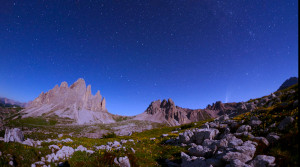Glossary term: Big Dipper
Description: The Big Dipper is a well-known star pattern (or asterism, to use the technical term) which is part of the constellation Ursa Major in the northern sky. It consists of eight stars: Alkaid, Mizar/Alcor, Alioth, Megrez, Phecda, Merak, and Dubhe (Mizar/Alcor is a double star). The end two stars in the bowl of the Dipper can be used to locate the North Star (Polaris). The fact that the eight stars are similar in brightness makes the Big Dipper especially notable (though Megrez and Alcor are slightly fainter than the others) and it has been known under various names in many cultures. The five middle stars are part of a group of stars moving through space together (the Ursa Majoris Moving Group). Dubhe is reddish; the other seven stars are white.
Related Terms:
See this term in other languages
Term and definition status: This term and its definition have been approved by a research astronomer and a teacher
The OAE Multilingual Glossary is a project of the IAU Office of Astronomy for Education (OAE) in collaboration with the IAU Office of Astronomy Outreach (OAO). The terms and definitions were chosen, written and reviewed by a collective effort from the OAE, the OAE Centers and Nodes, the OAE National Astronomy Education Coordinators (NAECs) and other volunteers. You can find a full list of credits here. All glossary terms and their definitions are released under a Creative Commons CC BY-4.0 license and should be credited to "IAU OAE".
Related Media
Constellations from the World
Credit: Stephanie Ye Ziyi/IAU OAE
License: CC-BY-4.0 Creative Commons Attribution 4.0 International (CC BY 4.0) icons
Big Dipper
Credit: Arya Anthony/IAU OAE
License: CC-BY-4.0 Creative Commons Attribution 4.0 International (CC BY 4.0) icons
Dreamlike Starry Sky and Airglow
Credit: Likai Lin/IAU OAE
License: CC-BY-4.0 Creative Commons Attribution 4.0 International (CC BY 4.0) icons
Big Dipper in Four Seasons
Credit: Giorgia Hofer/IAU OAE
License: CC-BY-4.0 Creative Commons Attribution 4.0 International (CC BY 4.0) icons
Big Dipper and Comet Neowise C2020 F3
Credit: Giorgia Hofer/IAU OAE (CC BY 4.0)
License: CC-BY-4.0 Creative Commons Attribution 4.0 International (CC BY 4.0) icons
The Big Dipper in the Polar Night
Credit: Stephanie Ziyi Ye/IAU OAE (CC BY 4.0)
License: CC-BY-4.0 Creative Commons Attribution 4.0 International (CC BY 4.0) icons
The Big Dipper with the Sardinia Radio Telescope SRT
Credit: Antonio Finazzi/IAU OAE (CC BY 4.0)
License: CC-BY-4.0 Creative Commons Attribution 4.0 International (CC BY 4.0) icons
Big Dipper Over the Mono Lake
Credit: Fabrizio Melandri/IAU OAE (CC BY 4.0)
License: CC-BY-4.0 Creative Commons Attribution 4.0 International (CC BY 4.0) icons
The Rotating Planet
Credit: Jianfeng Dai/IAU OAE (CC BY 4.0)
License: CC-BY-4.0 Creative Commons Attribution 4.0 International (CC BY 4.0) icons
Related Activities
Moving constellations
astroEDU educational activity (links to astroEDU website) Description: Let's learn how stars in constellations move through time using real astronomical images.License: CC-BY-4.0 Creative Commons Attribution 4.0 International (CC BY 4.0) icons
Tags: Software , Data analysis , stellarium , gaia , hipparcos , ursa major Age Ranges: 10-12 , 12-14 , 14-16 , 16-19 , 19+ Education Level: Middle School , Secondary Areas of Learning: Guided-discovery learning , Observation based , Technology-based Costs: Free Duration: 3 hours Skills: Analysing and interpreting data , Asking questions , Communicating information , Developing and using models , Engaging in argument from evidence

















